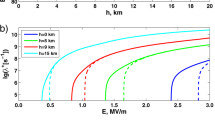Abstract
IONS in concentrations of about 102 to 103 cm−3 have been measured during day and night by means of rockets in the mesosphere. The resulting data have been used by Bragin et al.1,2 as the basis of two hypotheses: (1) that the high concentrations of ions below 90 to 80 km is produced during both day and night by the ionising agent (the flow of particles with medium energies) and (2) that the D region of the ionosphere below 80 km is formed in daytime because of the photodetachment of electrons from negative ions by photons of sunlight with energies below 10 eV. No assumptions have been made about the nature of the negative ions involved. The data for the actual aeronomic reactions used were as follows: (1) the rate coefficient of the detachment of electrons from the negative ions was assumed to be 10−2 to 5 × 10−1 s−1; (2) the rate coefficient of the detachment of electrons from negative ions by processes other than photodetachment was assumed to be of the order of 1 s−1 at 60 km, and 10−1 to 10−2 s−1 at 80 km; (3) the rate of attachment of electrons to the molecular oxygen was assumed to be 1.5 × 10−30 [O2]2 cm3 s−1, where [O2] is the concentration of the molecular oxygen corresponding to the standard atmosphere.
This is a preview of subscription content, access via your institution
Access options
Subscribe to this journal
Receive 51 print issues and online access
$199.00 per year
only $3.90 per issue
Buy this article
- Purchase on Springer Link
- Instant access to full article PDF
Prices may be subject to local taxes which are calculated during checkout
Similar content being viewed by others
References
Bragin, Yu. A., Kostko, O. K., Repnev, A. I., and Shvidkovsky, E. G., Kosmicheskije issledovanija, 5, 97 (1967).
Bragin, Yu. A., Kostko, O. K., Repnev, A. I., and Shvidkovsky, E. G., Space Res., 8 (1968).
Thomas, L., Gondhalekar, P. M., and Bowan, M. R., Nature, 238, 89 (1972).
Thomas, L., Gondhalekar, P. M., and Bowan, M. R., J. atmos. terr. Phys., 35, 397 (1973).
Narcisi, R. S., Bailey, A. D., Della Lucca, L., Sherman, C., and Thomas, D. M., J. atmos. terr. Phys., 33, 1147 (1971).
Arnold, F., Kisset, J., Krankowsky, D., Wider, H., and Zähringer, J., J. atmos. terr. Phys., 33, 1169 (1971).
Bragin, Yu. A., Kochejev, A. A., and Bragin, O. A., Kosmicheskije issledovanija, 11, 2 (1973).
Bragin, Yu. A., Kosmicheskije issledovanija, 5, 951 (1967).
Orishich, T. I., Kochejev, A. A., Deminov, I. G., Kucenogij, K. P., and Goldman, B. M., Kosmicheskije issledovanija (in the press).
Bragin, Yu. A., Tjutin, A. A., and Kochejev, A. A., Kosmicheskije issledovanija (in the press).
Author information
Authors and Affiliations
Rights and permissions
About this article
Cite this article
BRAGIN, Y. Nature of the Lower D Region of the Ionosphere. Nature 245, 450–451 (1973). https://doi.org/10.1038/245450a0
Received:
Revised:
Issue Date:
DOI: https://doi.org/10.1038/245450a0
This article is cited by
Comments
By submitting a comment you agree to abide by our Terms and Community Guidelines. If you find something abusive or that does not comply with our terms or guidelines please flag it as inappropriate.



